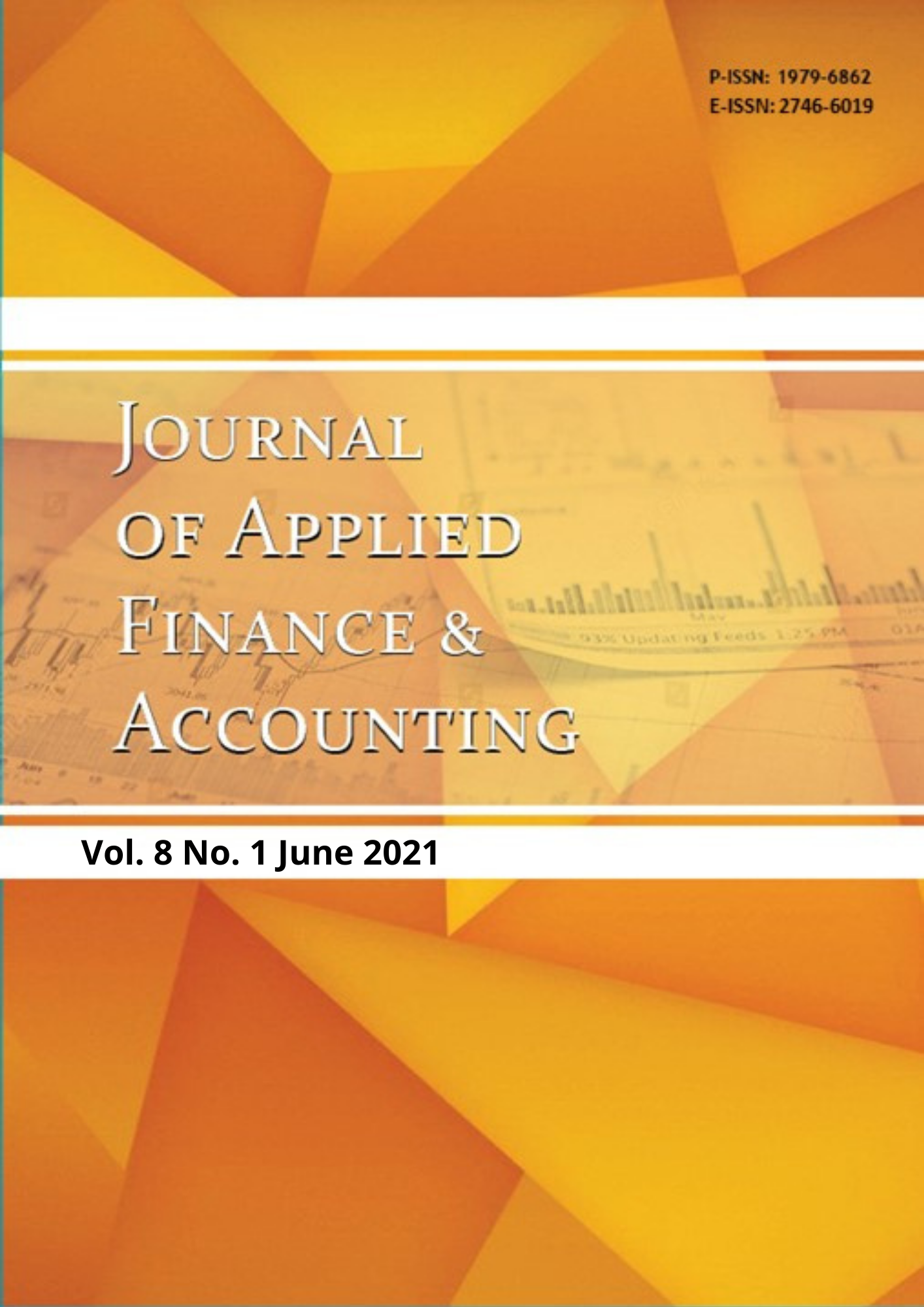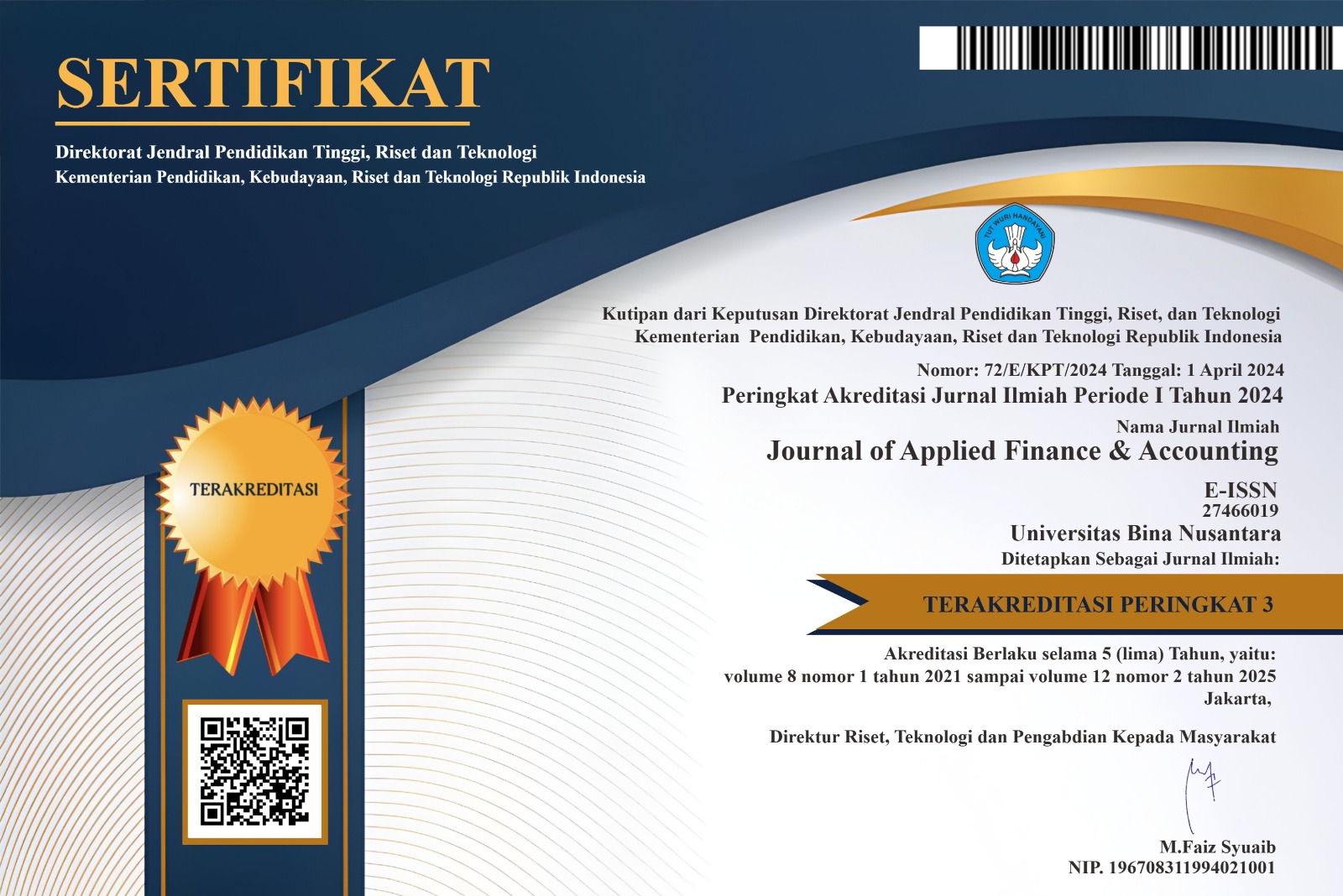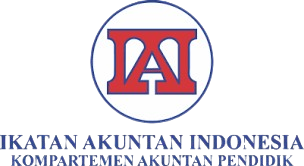DESIGNING VALUE ADDED TAX POLICY ON PEER-TO-PEER LENDING IN INDONESIA
DOI:
https://doi.org/10.21512/jafa.v8i1.7387Keywords:
fintech, peer-to-peer lending, value-added taxAbstract
Fintech is one of the newest business models in finance that take advantage of technological advances. One form of fintech in Indonesia is peer-to-peer lending. Based on the 1984 VAT Law, one service not subject to value-added tax is financial services. The reason globally for this is the difficulty in determining the tax base. However, according to the authors, these reasons cannot be accepted by considering the peer-to-peer lending business model. The authors provide reasons based on classical theory and existing empirical facts. This research outlines the urgency of establishing laws at the level of laws on fintech and the imposition of value-added taxes on peer-to-peer lending in Indonesia. In conclusion, the authors suggest that the government needs to (1) encourage the formation of laws and regulations at the level of the law on fintech to include criminal provisions such as laws in other financial institutions; (2) imposing a value-added tax on peer-to-peer lending, and (3) We encourage tax authorities to issue implementing regulations related to the imposition of value-added tax on peer-to-peer lending in Indonesia.
References
Afandi, M. A. (2020). Switching Intentions Among Millennial Banking Customers to Fintech Lending. International Journal of Islamic Economics and Finance (IJIEF), 3(2), 283–304.
Akseleran. (2020). Draft Perjanjian Standard Akseleran. https://core.akseleran.com/media/documents/template-documents/draft_perjanjian_standard_akseleran.pdf
Amartha. (2020). Manfaat Fintech untuk Perekonomian Indonesia. https://blog.amartha.com/manfaat-fintech-untuk-perekonomian-indonesia/
Arner, D. W., Barberis, J., & Buckley, R. P. (2015). The evolution of Fintech: A new post-crisis paradigm. Geo. J. Int’l L., 47, 1271.
Bachtiar, B. (2019). Metode Penelitian Hukum.
Benuf, K., Njatrijani, R., Priyono, E. A., & Adhim, N. (2020). Pengaturan Dan Pengawasan Bisnis Financial Technology Di Indonesia. Dialogia Iuridica: Jurnal Hukum Bisnis Dan Investasi, 11(2), 46–69.
BI. (2020). Financial technology. https://www.bi.go.id/id/edukasi-perlindungan-konsumen/edukasi/produk-dan-jasa-sp/fintech/Pages/default.aspx
Callaway, J. (2019). FinTech Disruption: Opportunities to Encourage Financial Responsibility. The Disruptive Impact of FinTech on Retirement Systems, 61.
Cargill, T. F. (2017). The financial system, financial regulation and central bank policy. Cambridge University Press.
Cerdasco. (2019). Disintermediasi. https://cerdasco.com/disintermediasi/
Chishti, S., & Barberis, J. (2016). The Fintech book: The financial technology handbook for investors, entrepreneurs and visionaries. John Wiley & Sons.
Cornelli, G., Frost, J., Gambacorta, L., Rau, R., Tania, R. W., & Ziegler. (2020). Fintech and big tech credit: a new database. https://www.bis.org/publ/work887.pdf
Darman. (2019). Financial Technology (FinTech): Karakteristik dan Kualitas Pinjaman pada Peer to Peer Lending di Indonesia. Jurnal Manajemen Teknolog, 18(2), 130–137.
https://journal.sbm.itb.ac.id/index.php/mantek/article/view/2853
Darussalam, Septriadi, D., & Dhora, K. A. (2018). Konsep dan Studi Komparasi Pajak Pertambahan Nilai (PPN). Penerbit DDTC.
Derayah Financial. (2017). A Concept Study on Peer-to-Peer Lending. https://web.derayah.com/wp-content/uploads/2017/12/concept_study_p2p_lending_17.pdf
Dermine, J. (2017). Digital disruption and bank lending. European Economy, 2, 63–76.
Firdaus, D. W., & Aryanti, R. K. (2019). The Influence of Financial Technology in Financial Transactions. IOP Conference Series: Materials Science and Engineering, 662(2), 22012.
Franedya, R. (2018). Ini Dia Empat Jenis Fintech di Indonesia. Ini Dia Empat Jenis Fintech di Indonesia
Fuad, N., Prabowo, H. A., & Budiarso, A. H. R. (2004). Dasar-dasar Keuangan Publik. Badan Pendidikan dan Pelatihan Keuangan. https://www.academia.edu/9689852/Dasar_Keuangan_Publik?auto=download
Hartanto, R., & Ramli, J. P. (2018). Hubungan Hukum Para Pihak dalam Peer to Peer Lending. Jurnal Hukum Ius Quia Iustum, 25(2), 320–338.
Iman, N. (2018). Is mobile payment still relevant in the fintech era? Electronic Commerce Research and Applications, 30, 72–82.
Indef. (2019). Studi Dampak Fintech P2P Lending terhadap Perekonomian Nasional. https://indef.or.id/source/research/Studi Dampak Fintech P2P Lending terhadap Perekonomian Nasional.pdf
Koinworks. (n.d.). Sejarah Peer-to-Peer Lending. https://koinworks.com/id/education-center/industri-peer-to-peer-lending
Lalujan, C. R. E. (2013). Analisis Penerapan Pajak Pertambahan Nilai Pada PT. Agung Utara Sakti Manado. Jurnal EMBA: Jurnal Riset Ekonomi, Manajemen, Bisnis Dan Akuntansi, 1(3).
Le, T. M. (2003). Value added taxation: Mechanism, design, and policy issues. Course on Practical Issues of Tax Policy in Developing Countries, April.
Leong, K., & Sung, A. (2018). FinTech (Financial Technology): what is it and how to use technologies to create business value in fintech way? International Journal of Innovation, Management and Technology, 9(2), 74–78.
Li, Y., Spigt, R., & Swinkels, L. (2017). The impact of FinTech start-ups on incumbent retail banks’ share prices. Financial Innovation, 3(1), 1–16.
Marzuki, P. M. (2017). Penelitian Hukum. Kencana Prenda Media.
McBride, S. (2017). NoPeer-to-Peer Lending Investor Guide Innovating an Ancient Credit Model. https://43cyu21tdz6o41fs2y3e45y1-wpengine.netdna-ssl.com/wp-content/uploads/2017/10/P2P-Lending-Guide-Final-Edition.pdf
Mishkin, F. S., & Eakins, S. G. (2018). Financial Markets And Institutions. Pearson Education Limited.
OJK. (2021). Penyelenggara Fintech Lending Terdaftar dan Berizin di OJK per 4 Mei 2021. Financial Technology. https://www.ojk.go.id/id/kanal/iknb/financial-technology/Pages/Penyelenggara-Fintech-Lending-Terdaftar-dan-Berizin-di-OJK-per-4-Mei-2021.aspx
Parlour, C. A., Rajan, U., & Zhu, H. (2019). Fintech disruption, payment data, and bank information. NBER Working Paper, 22476.
Puschmann, T. (2017). Fintech. Business & Information Systems Engineering, 59(1), 69–76.
Putra, I. S., Santoso, B., & Benuf, K. (2021). Online Dispute Resolution sebagai Alternatif Penyelesaian Sengketa Bisnis Financial Technology di Indonesia. Simbur Cahaya, 27(2), 1–22.
Ryu, H.-S. (2018). What makes users willing or hesitant to use Fintech?: the moderating effect of user type. Industrial Management & Data Systems.
Sandi, F. (2019). Terungkap, Fintech Berkontribusi Rp 60 T ke Ekonomi RI. https://www.cnbcindonesia.com/tech/20191111155625-37-114358/terungkap-fintech-berkontribusi-rp-60-t-ke-ekonomi-ri
Santi, E., Budiharto, B., & Saptono, H. (2017). Pengawasan Otoritas Jasa Keuangan Terhadap Financial Technology (Peraturan Otoritas Jasa Keuangan Nomor 77/POJK. 01/2016). Diponegoro Law Journal, 6(3), 1–20.
Sekaran, U., & Bougie, R. (2016). Research methods for business a skill building approach. John Wiley & Sons.
Stulz, R. M. (2019). Fintech, bigtech, and the future of banks. Journal of Applied Corporate Finance, 31(4), 86–97.
Sukardji, U. (2009). Modul Pajak Pertambahan Nilai Dan Pajak Penjualan Atas Barang Mewah. Pusdiklat Pajak.
Syah, R., Nasution, M. K. M., Nababan, E. B., & Efendi, S. (2020). Optimization Metrics Model: The Mobile Wallet for Merchant Ecosystem. Journal of Physics: Conference Series, 1566(1), 12124.
Tait, M. A. A. (1988). Value added tax: International practice and problems. International Monetary Fund.
Tampubolon, H. R. (2019). Seluk Beluk Peer to Peer Lending Sebagai Wujud Baru Keuangan di Indonesia. Jurnal Bina Mulia Hukum, 3(2), 188–198.
Techforid. (2019). Manfaat Fintech Bagi Masyarakat. https://www.techfor.id/manfaat-fintech-bagi-masyarakat/
Thuronyi, V. (1996). Tax Law Design and Drafting, Volume 1 (Vol. 1). International Monetary Fund.
Downloads
Published
Issue
Section
License
Authors who publish with this journal agree to the following terms:
Authors retain copyright and grant the journal right of first publication with the work simultaneously licensed under a Creative Commons Attribution License that allows others to share the work with an acknowledgement of the work's authorship and initial publication in this journal.
Authors are able to enter into separate, additional contractual arrangements for the non-exclusive distribution of the journal's published version of the work (e.g., post it to an institutional repository or publish it in a book), with an acknowledgement of its initial publication in this journal.
Authors are permitted and encouraged to post their work online (e.g., in institutional repositories or on their website) prior to and during the submission process, as it can lead to productive exchanges, as well as earlier and greater citation of published work (See The Effect of Open Access).





